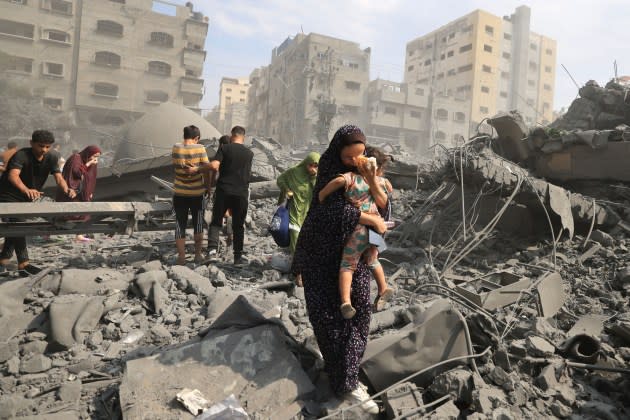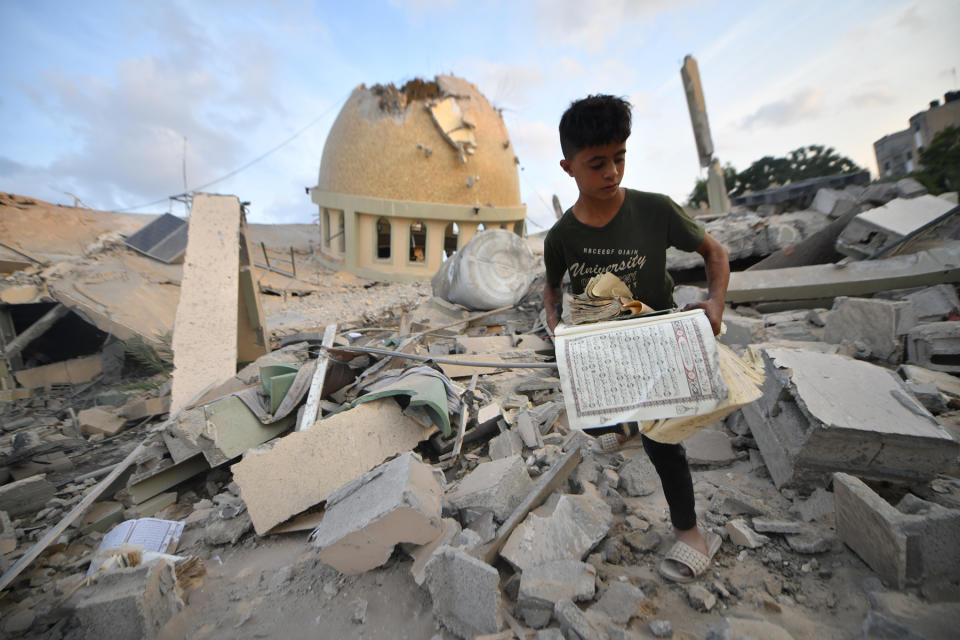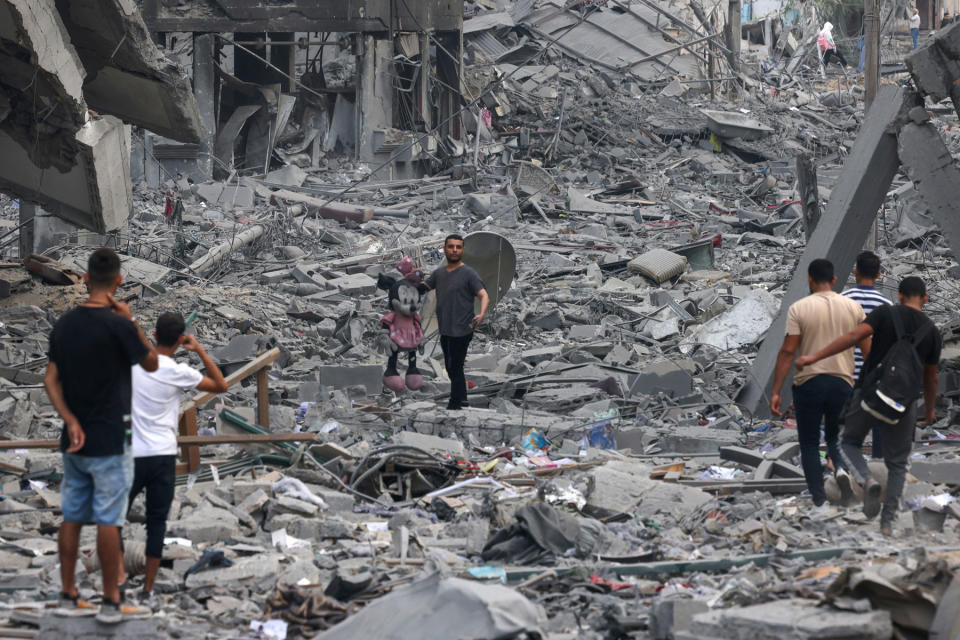Palestinians in Gaza Brace for All-Out War: ‘There Is No Place to Go’

Friday, Oct. 6, was an average day in the chaotic, fractured, and forcibly segregated Israeli-and-Palestinian new normal. The next day, Israeli and Palestinian society transformed in hours as Hamas led a bloody and unprecedented attack from Gaza that has plunged Israel and the occupied territories into new depths of a war without end. Nothing is normal now.
Since Saturday morning, at least 1,200 Israelis, mostly civilians, have been killed in an assault that has caused Israel more casualties than the country experienced during the entire five years of the Second Intifada that raged nearly 20 years ago. Twenty-four hundred have been wounded, and over 100 have been taken captive in Gaza. At the same time, 950 Palestinians have been killed and an estimated 5,000 wounded since Israel has responded with a punishing bombardment from air, land, and sea that is flattening neighborhoods in the long-besieged strip. More than 300 children are among the dead. Residents, who’ve endured a 16-year-long blockade, believe this is just the prelude to a mass invasion.
“There is no place to go. If I die, I will die in my home,” says Mohammad Rajab, 40, from his home in downtown Gaza City on Tuesday.
Like many Gaza residents, Rajab was stunned by the massive and ongoing surprise assault. Many Gazans were elated — not by the atrocities, with which they can grimly identify. They celebrated an inconceivable breaking of the siege. For Gazans, it was the bursting of the bubble that allowed Israelis to live cost-free while Israel denied them the most basic rights. Then the dread and panic of the Israeli response set in. As an unprecedented 300,000 Israeli troops now swell around Gaza in expectation of a ground invasion, it’s a response that has so far plunged Gaza into darkness; cut off food, water, and gas from entering the strip; and then there is the terrifying bombardment that residents describe as being far worse than 2014 — the last time Israel fought a ground war there.
Rajab’s phone shakes and freezes regularly on our video call as the blast of Israeli airstrikes shake his building. With the foreign press unable to reach Gaza, Rajab — a fixer for foreign journalists during previous conflicts — has spent the past several days and nights at home, sheltering relatives fleeing neighborhoods being flattened in the center of the strip. Stocked up on food and water, he wonders what will happen when it runs out. “Israel can’t say Hamas is like ISIS and then do the same thing to us,” he says.
As he speaks, Rajab struggles to pump out water from his living room that had just flooded in during a storm; he eyes his kids running around the building’s heavy metal-gated entrance way. They play loudly, as if trying to block out the sounds of death from above.

When Israeli airstrikes obliterated parts of Gaza’s densely populated Jabalia refugee camp in air raids on Monday, four of Mohammed Abdalla’s younger cousins were killed when bombs rained down on the market. On a video call, he camps out in the hallway of his wheelchair-bound mother’s fifth-floor apartment, gleaning what light he can from the window in the stairwell. Abdalla, 36, and his family are without power or water and have nowhere to go. The building elevator is out, and the airstrikes creep closer, jolting his building more violently each time.
“I don’t know where this is going to go,” he says crouched against the wall on a pillow and sporting a tight goatee. “Every day is worse than before.”
One of the few Gazans who have managed to leave the strip, Abdalla was living in Chile for the past few years, only returning to the confines of his homeland to care for his ill mother. In his previous Gaza life, fluency in English landed him a job at the Hamas-run government press office. However, unmarried and not a party member, he says he didn’t fit in. He has tried to make a career as a graphic designer, but, like more than 60 percent of Gaza, he struggles with unemployment.
With nowhere to run, he is horrified by Israeli calls for them to flee their homes to Egypt. It conjures up images of Israel’s expulsion of Palestinians during the 1948 Arab-Israeli war. On the other hand, he says, it sounds better than his fear of Israel reducing Gaza to rubble before a full-scale ground invasion.
Former Gaza health minister and representative of Hamas Basem Naim sees Saturday’s assault as “the start of a new era.” Speaking on the phone from Gaza, he knows the attack has transformed Israelis and scarred Netanyahu, whose political career was defined by maintaining unprecedented Israeli quiet through low-cost Gaza wars and unrelenting blockade. Well aware of the astonishing cost that will come from such a brutal and humiliating attack, he tries to focus on military success and downplay or ignore atrocities. Still, he conditions a restoration of calm with Israel on returning Palestinian prisoners, stopping provocative Jewish religious visits to the Al-Aqsa Mosque, ending its West Bank and East Jerusalem settlements and occupation, and lifting its blockade of Gaza. “You could say we have nothing left to lose.”
For Hamas, this brazen attack is the ultimate roll of the dice, one that appears based on preserving the idea of the movement even if war wrestles away its limited control. Its claim to the leadership of Palestinian armed struggle had been waning over the last year and a half.
Amid settler attacks and uncontested army raids on communities cut off from each other by walls and checkpoints, a young generation of independent Palestinian guerrillas had been defined by the Neyanyahu era of segregation. Driven by the notion that it’s better to die on your feet than live on your knees, they inspired a spreading rebellion amongst West Bank Palestinians. As they became a main force of nationalist armed resistance, Hamas’ popularity was sinking. With expanding power shortages and an inability to change the siege, consistent Palestinian polling showed, Hamas was becoming a dated idea in Palestinian minds.

When West Bank Palestinians woke up to a different kind of Israeli occupation on Saturday, Hamas was back at the center of it. When the Islamic nationalist movement’s notoriously mysterious military leader, Mohammed Deif, called for West Bank Palestinians, Palestinian citizens of Israel, and the entire Arab and Muslim world to rise up or join the fight, the Israeli military locked down and divided the West Bank, trapping Palestinians where they were. For the first few hours, even settler-accessed checkpoints into Jerusalem were closed.
As news of Israeli forces being overwhelmed and the breaking of Gaza’s confines sunk in, young Palestinians took the Israeli checkpoints that controlled their lives around the West Bank. At the daunting Qalandia checkpoint that separates Ramallah from most of occupied East Jerusalem, kids and teenagers from the adjacent refugee camp blocked the road with tire fires to throw rocks at soldiers. The Lions Den of Nablus and the new armed groups from Jenin looked to Hamas for the first time and expanded armed attacks on Israeli settlers and soldiers while calling for an uprising.
And in Ramallah, the hilltop seat of limited power for the Western-backed Palestinian security forces run by Palestinian Authority President Mahmoud Abbas’ secular nationalist Fatah movement, hundreds marched, carrying Hamas’ flags through the city center. Since then, the restrictions dividing the West Bank for Palestinians have only tightened, leaving them stranded where they were on Saturday while taking in Gazan workers from Israel seeking refuge. Checkpoint protests continue to rage as the IDF increases its use of live fire.
Shawan Jaberin, the 63-year-old head of the Ramallah-headquartered Palestinian human rights organization Al Haq, sees this attack and war as a watershed moment for Palestinians. He is horrified by the brutality displayed toward Israeli civilians in the Hamas-led assault backed by Palestinian Islamic Jihad. Examining its impact, however, he notes that pulling off an attack on this scale has shown Palestinians that while the international community won’t use any leverage to protect their rights, they can shape their own fate. “Hamas and Islamic Jihad are becoming like Fatah was in 1968,” says Jaberin, referring to the era of the Palestine Liberation Organization’s formation in the wake of the defeat in the 1967 Arab-Israeli war.
By Saturday evening, Israelis and Palestinians were still only beginning to see the scale of what had happened. While Western countries turned to their allies in the Palestinian Authority for answers, one Western diplomat says that behind the scenes the reply was blunt. “What did you think?” the diplomat recalls being told. “We fucking told you something like this could happen.”
More from Rolling Stone
As Israel Invades Rafah, People Flee Gaza's Last Standing City Into Rubble
Biden Appointee Becomes First Jewish Staffer to Resign Over Gaza
Best of Rolling Stone

